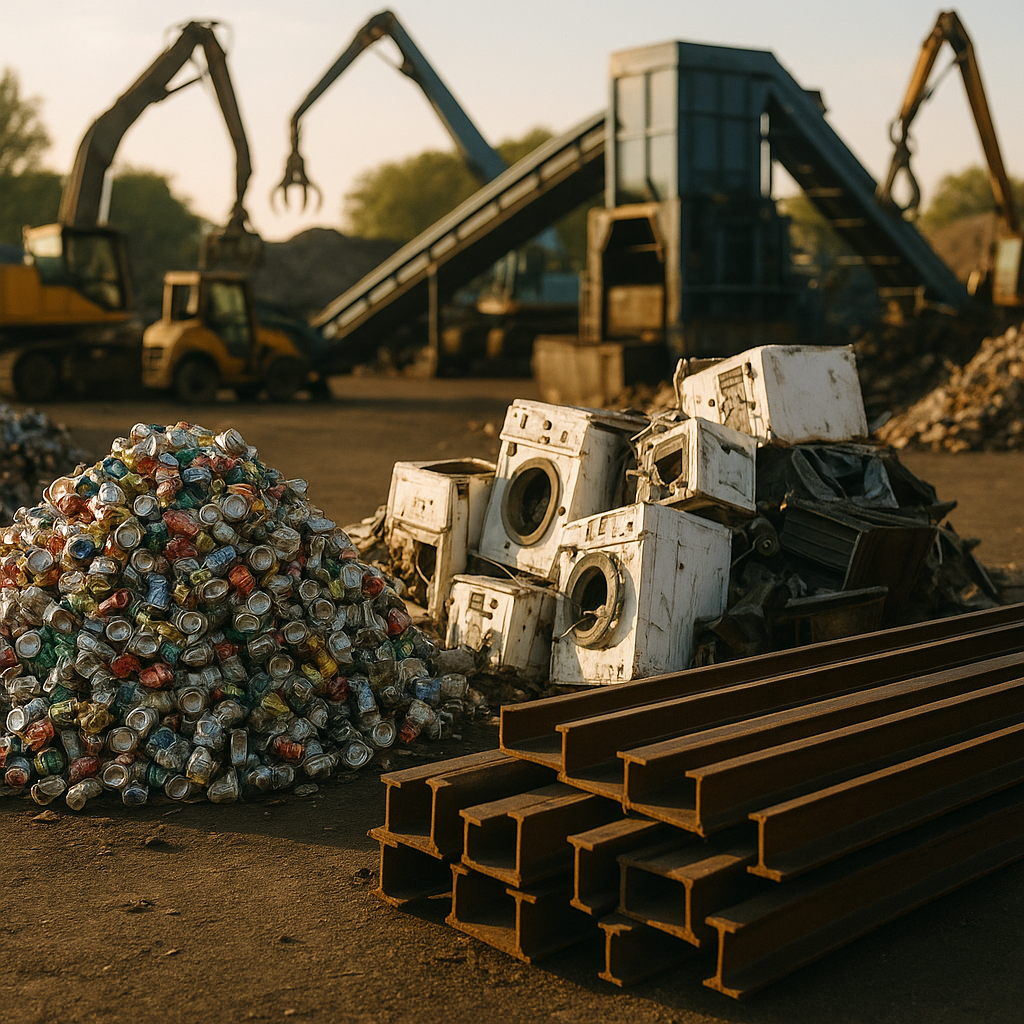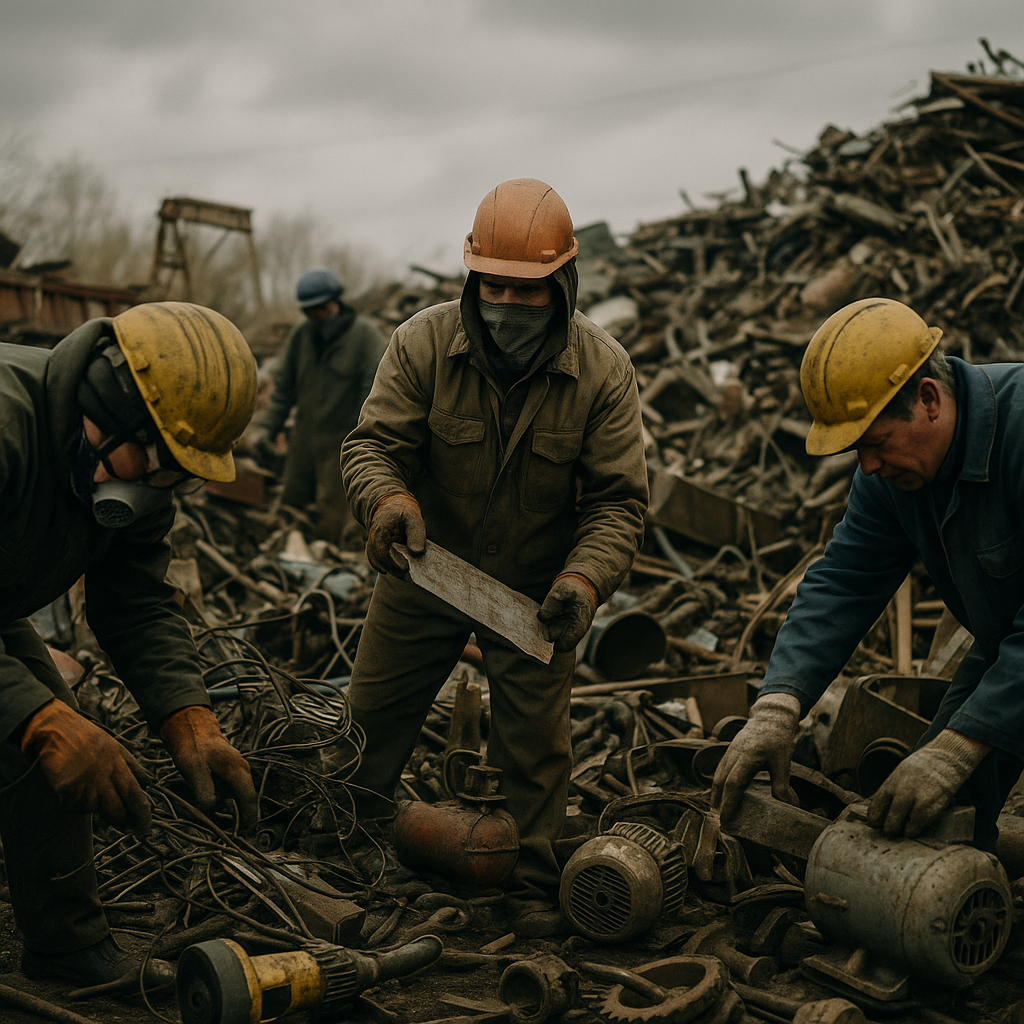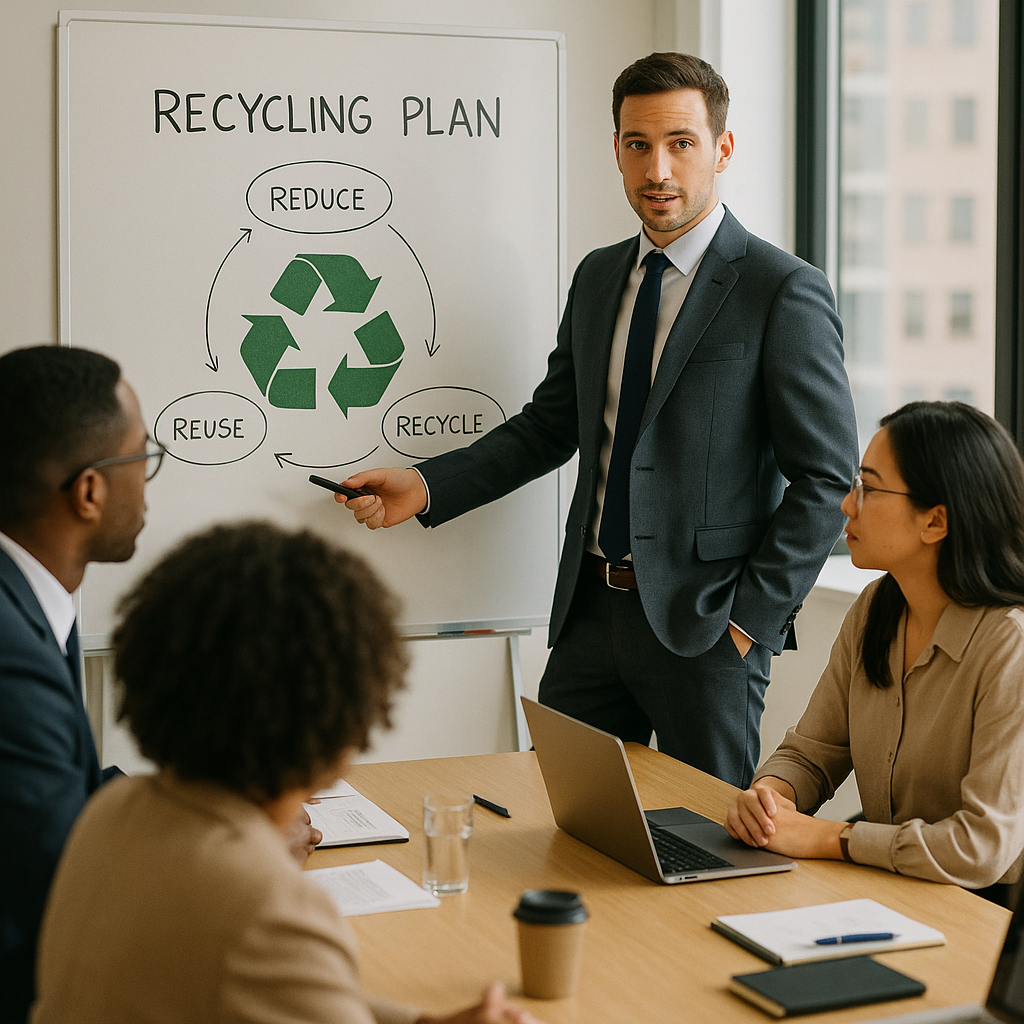5901 Botham Jean Blvd, Dallas, TX 75215
Scrap Sustainability: How Metal Recycling Fuels a Circular Economy
September 5, 2025Scrap sustainability is the cornerstone of modern resource management. It involves collecting and recycling end-of-life metal products to transform them into valuable raw materials for new goods. This process establishes a renewable cycle that significantly reduces dependence on virgin mineral resources, minimizes environmental impact, and supports economic growth.
Fundamentally, scrap sustainability embodies the principles of a circular economy. Unlike the traditional linear ‘take-make-dispose’ model that depletes finite resources, this approach maintains metals in continuous use. According to the International Aluminium Institute, recycling aluminum saves up to 95% of the energy required for production from primary materials, with similar reductions in greenhouse gas emissions.
The benefits extend beyond energy savings. Scrap metal recycling reduces air pollution by 80%, water pollution by 76%, and water consumption by 40% compared to extracting virgin materials. These figures indicate a fundamental shift in how we view what was once considered waste. Today’s scrap is tomorrow’s resource, creating a sustainable loop that benefits both our environment and economy.
How Does Scrap Metal Recycling Benefit the Environment?

Scrap metal recycling is one of the most effective ways to lessen environmental impact. The process transforms what would otherwise be waste into valuable resources while significantly reducing the ecological footprint associated with metal production.
Significant Energy Conservation
Recycling metals saves substantial amounts of energy compared to producing them from raw materials. Recycling aluminum, for instance, conserves 95% of the energy required to produce new aluminum from bauxite ore, while steel recycling conserves about 75% of the energy needed for primary production.
These energy savings have tangible benefits. For every ton of steel recycled, manufacturers conserve enough energy to power 18 million homes for a year. The cumulative effect of metal recycling results in massive energy savings across industrial sectors.
The Institute of Scrap Recycling Industries reports that metal recycling annually saves enough energy to power approximately 20 million households for a full year. This conservation reduces pressure on power grids and decreases our reliance on fossil fuels.
Greenhouse Gas Emissions Reduction
Producing metal from raw ore releases significant amounts of carbon dioxide and other greenhouse gases. Recycling drastically cuts these emissions. According to the Environmental Protection Agency, recycling one ton of steel prevents approximately 1,000 to 1,500 pounds of carbon dioxide from releasing into the atmosphere.
Studies indicate that recycling steel and aluminum can reduce greenhouse gas emissions by 86% and 95%, respectively. The EPA reports that metal recycling reduces greenhouse gas emissions by 29 million tons of carbon dioxide annually—equivalent to removing 6.3 million cars from the roads.
This reduction in emissions plays a crucial role in combating climate change. Every piece of scrap metal diverted to recycling directly contributes to lowering our collective carbon footprint.
Natural Resource Conservation
Metal extraction through mining can severely damage the environment, causing habitat destruction, soil erosion, and chemical contamination. Recycling one ton of steel conserves approximately 2,500 pounds of iron ore, 1,400 pounds of coal, and 120 pounds of limestone.
Metal resources are finite, and without conservation efforts, current reserves will eventually deplete. Recycling extends the lifecycle of these materials, reducing the need to extract new resources from the Earth.
The conservation benefits also extend to water resources. Metal recycling can significantly reduce water consumption—recycling copper can decrease water use by as much as 90% compared to primary production methods.
| Metal Type | Energy Savings | CO2 Emissions Reduction |
|---|---|---|
| Aluminum | 95% of the energy needed for primary production | 92% compared to raw aluminum |
| Steel | 60-75% energy savings | 1,000 to 1,500 pounds per ton of steel |
| Copper | 85% of the energy needed for primary production | 65% reduction in emissions |
Landfill Waste Reduction
Metals discarded in landfills take hundreds or even thousands of years to break down naturally. Recycling these materials prevents them from occupying valuable landfill space, which is particularly important as suitable landfill sites become increasingly scarce.
Metals in landfills pose long-term environmental risks. Many contain harmful chemicals, such as lead, mercury, and cadmium, which can leach into soil and groundwater if improperly disposed of. Recycling prevents these toxic substances from contaminating local water sources.
The reduction in landfill volume is significant. Metal waste accounts for a substantial portion of landfill materials by weight. Each ton of metal recycled represents cubic yards of landfill space preserved for waste that cannot be recycled.
Reduced Mining Impact
Metal extraction involves extensive land disturbance that harms landscapes and ecosystems. Recycling scrap metal significantly reduces the need for mining operations, conserving natural habitats, preventing soil erosion, and maintaining biodiversity in mining-prone areas.
Mining operations often contaminate waterways with heavy metals and processing chemicals. By reducing mining activity through recycling, we help protect water quality in streams, rivers, and groundwater systems near extraction sites.
Communities near mining operations frequently experience air quality issues from dust and emissions. Recycling helps mitigate these impacts by decreasing the demand for newly extracted materials, protecting both environmental and public health.
The environmental benefits of scrap metal recycling create a powerful ripple effect throughout our ecosystem. Each piece of metal recycled contributes to energy conservation, emissions reduction, resource preservation, and environmental protection, making recycling one of the most impactful environmental choices available to industries and individuals alike.
What Economic Advantages Does Scrap Metal Recycling Offer?
The scrap metal recycling industry serves as a significant economic driver in the United States, generating over $105 billion in annual economic activity. This impressive figure places the industry alongside other major sectors like cosmetics and aircraft engines, transforming what is often seen as mere waste into a manufacturing success story with extensive financial benefits.
Revenue Generation and Tax Contributions
Scrap metal recycling significantly contributes to government revenue at multiple levels, generating approximately $10.3 billion in tax revenues annually for federal, state, and local governments. These funds support essential public services such as schools, emergency services, infrastructure projects, and community development initiatives.
The export market represents another economic benefit. Recycled scrap commodities are among America’s largest exports by value, with materials sold to more than 160 countries worldwide. In recent years, these exports have contributed nearly $24 billion in sales, accounting for about 39% of the industry’s economic activity.
The fiscal impact extends beyond direct tax contributions. The broader economic activity generated by recycling operations creates additional sales tax revenue, while employees contribute through income tax payments, further strengthening local economies.
Cost Reduction Across Industries
Manufacturing businesses experience substantial cost savings using recycled metals instead of virgin materials. The processes of mining, extraction, and refining virgin metals significantly increase production costs. Recycled materials require considerably less processing, providing immediate savings that can be passed along to consumers.
The energy conservation aspect offers additional economic benefits. Recycling aluminum uses only 5% of the energy required to produce primary aluminum from raw ore. Steel recycling conserves up to 74% of the energy compared to virgin steel production. These energy savings reduce manufacturing costs, shielding businesses against energy price fluctuations.
Recycled metals also help companies stabilize budgets amidst volatile global metal markets. While virgin material prices can fluctuate dramatically with supply chain disruptions, recycled materials typically offer more consistent pricing structures, allowing for better long-term financial planning.
Landfill Diversion and Environmental Economics
By diverting materials from landfills, scrap metal recycling generates significant cost savings for municipalities and waste management systems. Rising landfill tipping fees due to limited capacity and stricter environmental regulations mean that keeping metal out of waste streams creates immediate financial benefits.
Many municipalities and waste management companies offer rebates or reduced collection rates for businesses with effective recycling programs. Additionally, the reduced pollution from minimized mining and refining activities lowers public health expenses and environmental remediation costs.
Water conservation represents another economic advantage, as metal production from raw ore requires significant water resources for processing and cooling. Recycling dramatically reduces water consumption, leading to lower utility expenses for manufacturers and better protection against drought-related price increases.
The scrap metal recycling industry shows that environmental responsibility and economic prosperity can work hand in hand, creating a more sustainable and financially robust economy for future generations.
| Economic Impact | Value |
|---|---|
| Total Economic Activity Generated | $105 billion annually |
| Jobs Supported | 500,000 jobs |
| State and Local Tax Revenue | $4.4 billion annually |
| Federal Tax Revenue | $6.8 billion annually |
| Export Contribution | 26.8% of industry activity |
What Are the Key Challenges in Scrap Metal Recycling?

The scrap metal recycling industry faces a range of challenges that impact its operations and long-term sustainability. These issues span from economic uncertainties to regulatory pressures, each necessitating strategic solutions to ensure the industry’s continued success.
Market Price Volatility
One of the most significant challenges is price volatility. Market prices can fluctuate by up to 30% in a single month, creating planning difficulties for recycling operations. These fluctuations are driven by global economic trends, trade policies, and shifts in supply-demand dynamics.
Volatility directly affects the profitability and operational stability of recycling facilities. When prices drop abruptly, materials collected at higher prices can lead to financial losses. Recyclers must develop strong inventory management systems to effectively handle these unpredictable market conditions.
Global factors greatly impact local markets. For example, when China implemented its National Sword policy to restrict scrap imports, it caused ripple effects throughout the global recycling ecosystem. US scrap dealers who previously relied on Chinese demand faced oversupply issues, resulting in dramatically falling domestic prices.
Regulatory Compliance Challenges
The evolving regulatory landscape for scrap metal recycling generates both opportunities and obstacles. Environmental regulations impose significant compliance costs, requiring investments in pollution control equipment, monitoring systems, and administrative processes.
Water quality regulations pose specific challenges. The Clean Water Act mandates that scrap yards implement stormwater management plans and secure permits for water discharges. These systems are expensive to install and maintain, creating downward pressure on the prices recyclers can offer suppliers.
While these regulations promote important environmental goals, they also impose financial burdens that affect competitiveness. Legitimate recyclers must balance regulatory compliance with economic viability, especially when competing against unregulated operators who may not adhere to the same standards.
Competition from Unregulated Operators
Illegal or unregulated scrap operations undermine legitimate businesses by neglecting environmental and safety standards. This unethical competition harms the environment and damages the industry’s reputation while creating an uneven playing field for compliant recyclers.
These operators often avoid the costs associated with proper handling, processing, and disposal of hazardous materials. By bypassing regulations, they can offer higher prices to suppliers or undercut legitimate recyclers in the marketplace. Combating these illegal operations requires collaboration between industry associations, regulatory bodies, and law enforcement.
Public Awareness Gaps
A significant challenge for the scrap metal industry is the lack of public awareness about proper recycling practices. Many consumers and businesses are unaware of what materials can be recycled, how they should be prepared, and where they should be taken.
This knowledge gap leads to contamination issues when non-recyclable materials or improperly prepared items enter the recycling stream. Contamination reduces the quality of recyclable materials and increases processing costs substantially. Material contamination is one of the most common operational challenges facing recyclers today.
Educational initiatives aimed at businesses, individuals, and recycling professionals can significantly improve the quality of collected scrap. Community outreach programs that demonstrate proper recycling methods help reduce contamination rates and enhance the overall efficiency of the recycling process.
Technological Adaptation Requirements
The need to continually adopt and implement new technologies presents both a challenge and an opportunity. Advanced sorting systems, artificial intelligence, and machine learning applications offer solutions to many industry problems but demand significant capital investment.
Automated sorting technologies can significantly enhance the identification and separation of different metals with exceptional accuracy. These systems use sensors, infrared scanning, and x-ray technology to process larger volumes more quickly while maintaining higher purity levels.
While these technological investments can eventually lower labor costs and improve operational efficiency, the initial investment can be prohibitive for smaller recyclers. This creates a competitive advantage for larger operations with greater access to capital, potentially leading to industry consolidation.
How Can Individuals and Businesses Support Scrap Sustainability?

A business manager engages the team by presenting a recycling plan, fostering collaboration in a bright office environment.
Individual Actions That Make a Difference
Every household produces metal waste that can be diverted from landfills. Start by separating aluminum cans, steel food containers, and other metal items from regular trash. Clean these items before recycling to prevent contamination. Recycling experts note that even small metal items like bottle caps and paperclips can be recycled when collected properly.
Conduct a “metal audit” of your home. Identify unused appliances, tools, or electronics containing valuable metals. Instead of letting these items gather dust, take them to local recycling centers where their materials can be recovered and reused. Many communities offer special collection days for larger metal items like refrigerators or washing machines.
When purchasing products, choose items made from recycled metal. These products typically require less energy to produce than those made from virgin materials. By opting for recycled content, you create market demand that supports the entire recycling ecosystem.
Business Recycling Strategies
Businesses generate significant amounts of scrap metal through operations, equipment upgrades, and facility maintenance. Implementing a comprehensive metal recycling program starts with a waste audit to identify all potential recyclable materials. Train employees on proper sorting techniques to maximize the value of collected materials.
Partner with reputable scrap collectors who can provide appropriate containers and regular pickup schedules. These partnerships often generate revenue streams from valuable metals like copper, aluminum, and stainless steel. Some recycling providers also offer documentation of materials diverted from landfills, supporting sustainability reporting.
Supply chain sustainability represents another opportunity for business impact. Work with suppliers to reduce metal packaging waste or implement take-back programs for end-of-life products. Consider joining industry coalitions focused on metal recycling to share best practices and develop innovative approaches to waste reduction.
Community Initiatives and Partnerships
Local recycling drives create opportunities for both individuals and businesses to engage in scrap sustainability. Schools, community centers, and religious organizations often host collection events that accept everything from aluminum cans to obsolete electronics. These initiatives raise awareness while making recycling more accessible.
Educational workshops teach proper recycling techniques and highlight the environmental benefits of metal recovery. Businesses can sponsor these events or provide expertise about specific materials. Some companies offer tours of their recycling operations to show how materials are processed and reused.
Strategic partnerships between businesses and environmental organizations enhance recycling efforts. These relationships provide expertise and guidance on effective practices. Organizations focused on sustainability help maximize the impact of recycling programs through proven strategies, positioning businesses as environmental leaders in their communities.
Consumer Choices That Support Sustainability
Purchasing decisions directly influence manufacturing practices. When consumers consistently choose products with recycled content or recyclable packaging, companies respond by incorporating these features into more product lines. Look for labels indicating recycled metal content when shopping for everything from vehicles to household goods.
Repair rather than replace metal items whenever possible. This approach extends product lifecycles and reduces demand for new materials. Many communities have repair cafes or workshops where volunteers help fix broken items, keeping them in circulation longer.
Share information about proper metal recycling through social networks and community forums. Personal recommendations often motivate friends and family to adopt more sustainable practices. Consider organizing neighborhood collection efforts to make recycling more convenient and build community connections around environmental goals.
Conclusion: The Future of Scrap Sustainability

Scrap metal recycling is at the intersection of environmental responsibility and economic vitality. The industry’s future is increasingly tied to technological advancements, such as AI-powered sorting systems and blockchain technology, which enhance supply chain transparency. These innovations improve recycling efficiency and ensure the production of high-quality recycled materials for manufacturing sectors worldwide.
The environmental advantages of scrap sustainability make a strong case for its broader adoption. Scrap recycling reduces the need for raw material extraction, conserving natural resources and limiting habitat destruction. Recycling aluminum, for example, saves up to 95% of the energy required for new production, significantly decreasing greenhouse gas emissions. These practices support a circular economy where materials are used longer, maximizing their value while reducing waste and pollution.
For your recycling needs and to join the movement toward a more sustainable future, contact Okon Recycling at 214-717-4083.
